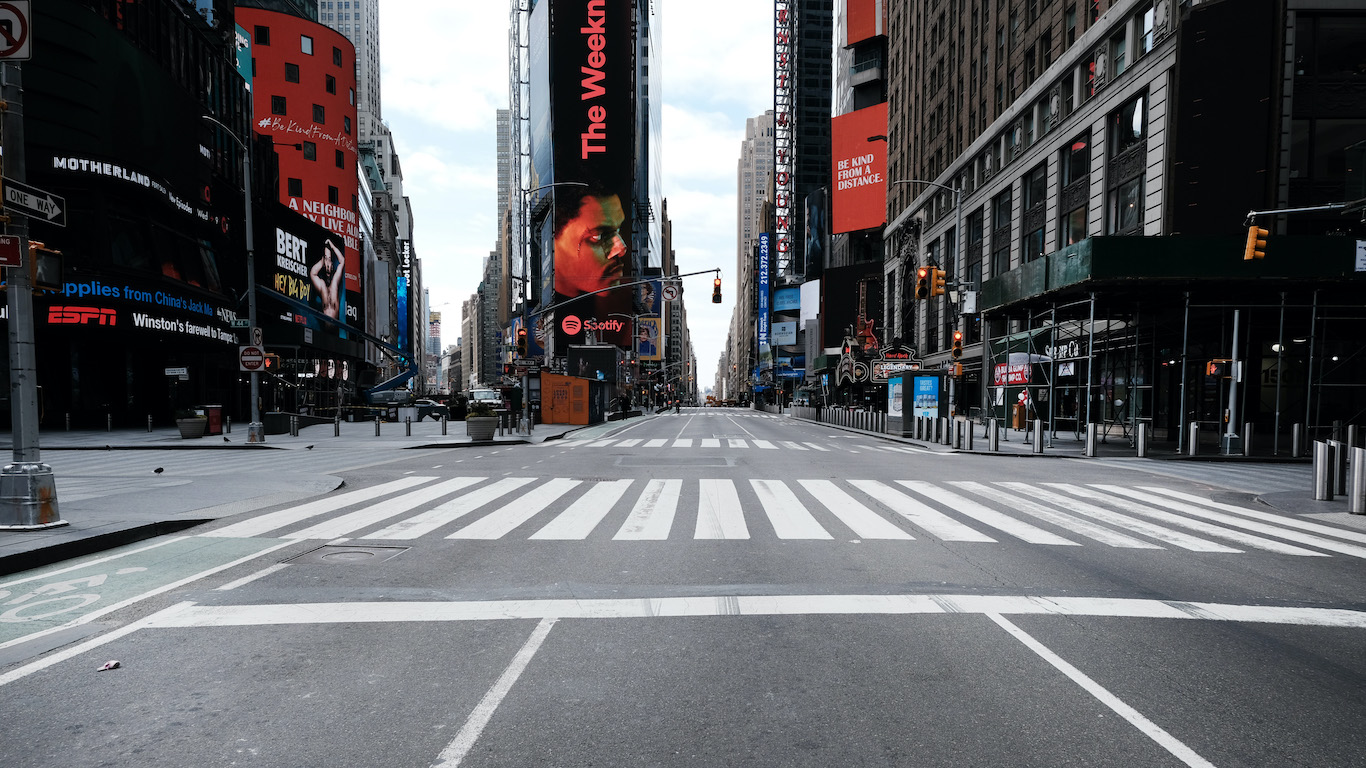

There have been over 350,000 confirmed cases of COVID-19 and more than 10,000 related deaths in the United States to date. To slow the spread of the novel coronavirus and save lives, more than 311 million people nationwide are being urged or ordered by their state or local government to stay at home. While public health is the top national priority, the measures taken to fight the virus have come at a steep cost, as much of the economy has effectively ground to a halt.
As more states and municipalities have been issuing stay-at-home directives, a record 10 million Americans have filed for unemployment over the last two weeks. The unemployment rate jumped from a historic low of 3.5% in February to 4.4% in March — and some experts predict it now stands at around 13%.
While every American will feel the effects of the economic downturn to some degree, certain industries are expected to bear the brunt of the decline. According to analysis by Moody’s Analytics, these industries include leisure and hospitality, travel services, transportation and warehousing, and oil and gas extraction. Here is an in-depth look at the U.S. industries being devastated by the coronavirus. In some parts of the country, these industries are economic pillars.
To identify the places a COVID-19 recession will likely hit hardest, 24/7 Wall St. created an index comprising three measures: employment in highly-exposed industries, COVID-19 infection rates, and population density. We only considered counties that lie within metropolitan areas.
In an attempt to lessen the impact of containing the coronavirus, President Donald Trump signed a $2 trillion economic stimulus bill. The bill, which will provide financial relief for families and businesses, has also calmed some investors after a historic sell-off on Wall Street. Here is how the current stock market collapse compares with others in history. Still, the economic devastation wrought by the efforts to contain the spread of the coronavirus will likely be felt long after the pandemic ends.
Click here to see the places a COVID-19 recession will likely hit hardest
Click here to read our methodology

30. New York County, New York
> Workforce in high-risk industries: 16.1%
> COVID-19 cases per 10,000: 51.1 (as of March 31, 2020)
> Jan. 2020 unemployment rate: 3.2%
> Total population: 1.6 million
> Metropolitan area: New York-Newark-Jersey City
Many now consider New York state to be the epicenter of the coronavirus outbreak in the United States, largely because of the high concentration of confirmed cases in New York City. New York County — coterminous with the borough of Manhattan — had a near nation-leading rate of infection as of the end of March, with 51.1 cases per 10,000 people. As of April 6, there were over 10,000 confirmed cases of COVID-19 in Manhattan alone.
While no county or county equivalent on this list has been hit as hard by the virus in terms of cases and infection rate as New York County has, the share of workers in industries at greatest risk of slowdown due to the pandemic and containment efforts is relatively low in Manhattan. The area has only slightly higher than average employment in the leisure and hospitality and employment services industries.
[in-text-ad]

29. Wilson County, Tennessee
> Workforce in high-risk industries: 31.6%
> COVID-19 cases per 10,000: 2.4 (as of March 31, 2020)
> Jan. 2020 unemployment rate: 2.9%
> Total population: 132,663
> Metropolitan area: Nashville-Davidson–Murfreesboro–Franklin
The economy in Wilson County, Tennessee, is more exposed to devastation by the coronavirus than any other county in the Nashville area. According to research by credit rating agency Moody’s, the transportation and leisure and hospitality industries are at especially high risk for decreased demand, shutdowns, and layoffs related to COVID-19. And in Wilson County, 17.4% of workers are employed in transportation and 12.2% in leisure and hospitality, larger shares than in the vast majority of U.S. counties.
As of the end of March, there have been 32 confirmed cases of coronavirus in Wilson County.
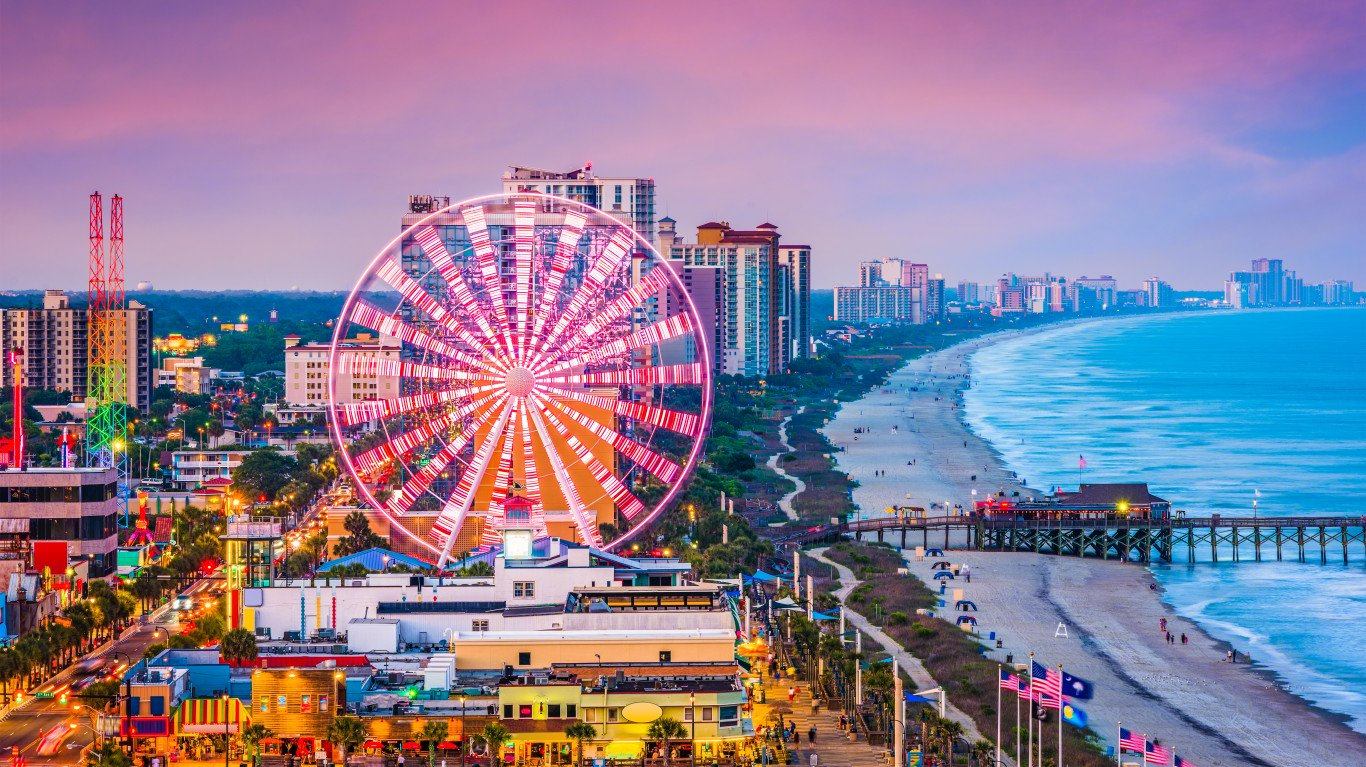
28. Horry County, South Carolina
> Workforce in high-risk industries: 31.8%
> COVID-19 cases per 10,000: 1.2 (as of March 31, 2020)
> Jan. 2020 unemployment rate: 4.4%
> Total population: 320,915
> Metropolitan area: Myrtle Beach-Conway-North Myrtle Beach
Horry County, South Carolina, located in the Myrtle Beach metropolitan area, is a popular tourist destination — and the tourism industry is projected to be among the hardest hit by the coronavirus pandemic. According to some estimates, the tourism industry is shedding jobs at a rate of one million a day. In Horry County, more than 37,000 workers, or 28.3% of the workforce, are employed in leisure and hospitality.
So far, the virus has not spread across Horry County as much as it has in other parts of the country. However, densely populated areas tend to be more susceptible to outbreaks, and in Horry County, there are 283 people per square mile, more than triple the national population density of 91 people per square mile.
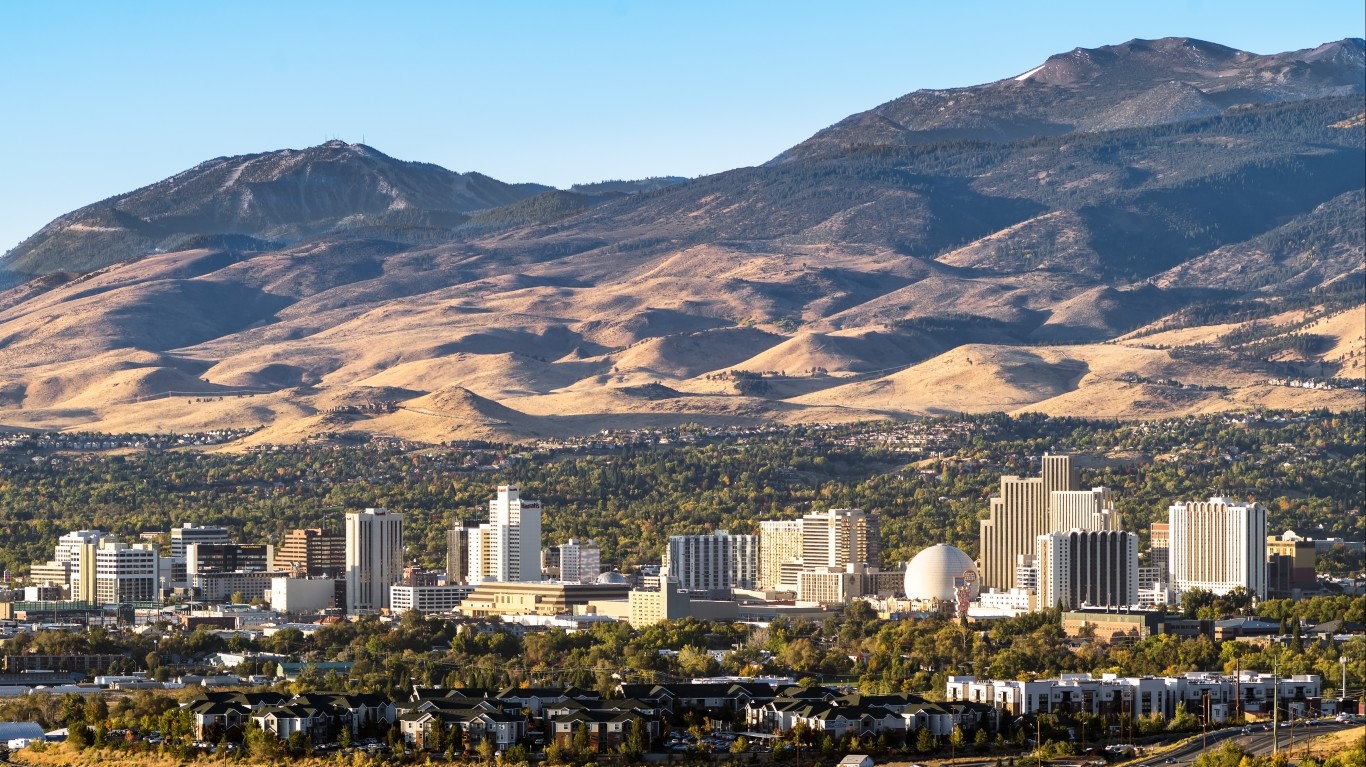
27. Storey County, Nevada
> Workforce in high-risk industries: 32.1%
> COVID-19 cases per 10,000: N/A (as of March 31, 2020)
> Jan. 2020 unemployment rate: 3.8%
> Total population: 3,941
> Metropolitan area: Reno
Storey County, located in the Reno metro area, depends heavily on the transportation and warehousing industry,which is expected to experience a sharp decline in demand in both the commercial and consumer markets. Truck transportation, the industry’s largest subsector, is already experiencing declines in the face of disruptions in the global supply chain. The unemployment rate in the county currently stands at 3.8%, a figure that will likely rise substantially as over 5,000 workers in the county are at particularly high risk of losing their jobs.
[in-text-ad-2]
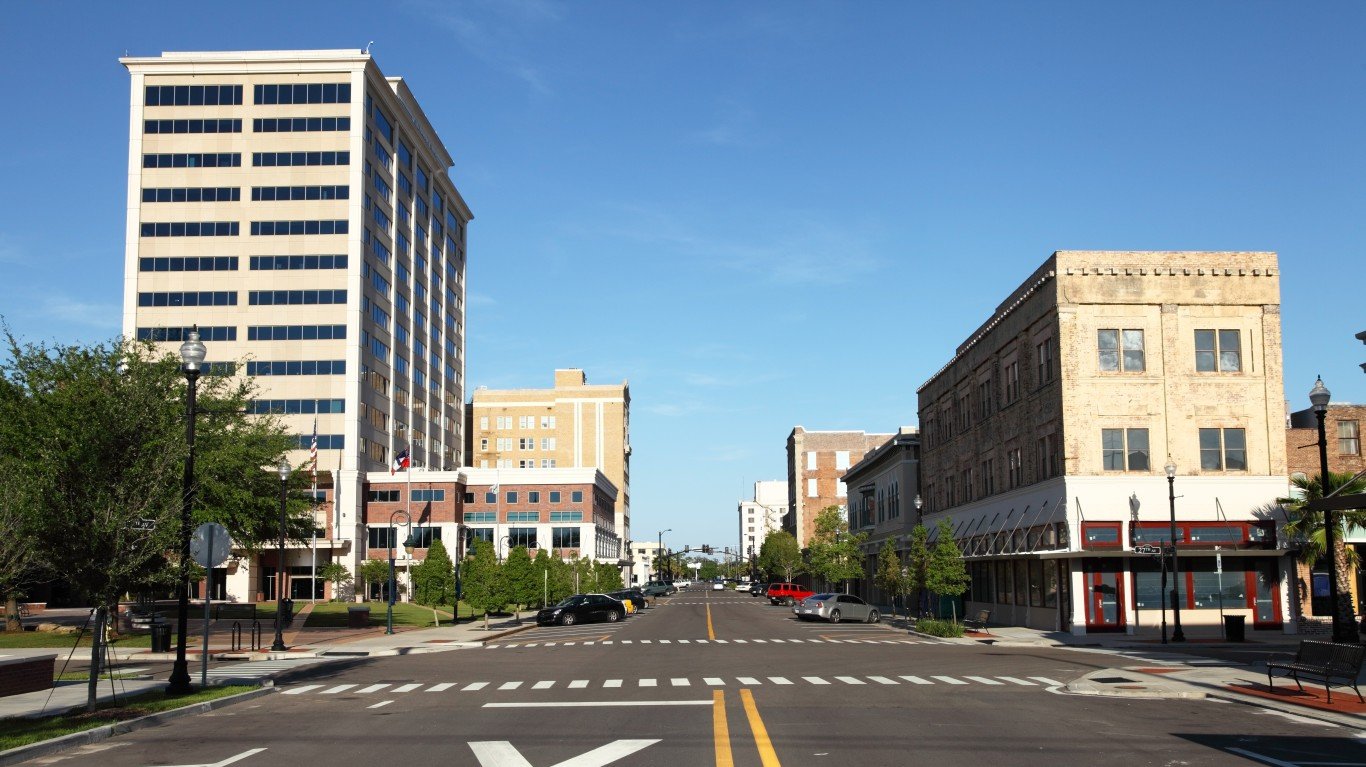
26. Harrison County, Mississippi
> Workforce in high-risk industries: 32.0%
> COVID-19 cases per 10,000: 2.2 (as of March 31, 2020)
> Jan. 2020 unemployment rate: 5.0%
> Total population: 202,626
> Metropolitan area: Gulfport-Biloxi
Nearly one-third of the 85,600 people working in Harrison County, Mississippi, are employed in industries that are at high-risk of slowdown due to the coronavirus outbreak. Non-essential travel has effectively been ground to a halt in the United States, and in Harrison County, located along the Gulf Coast in the Gulfport-Biloxi metro area, more than 23,000 people work in the leisure and hospitality industry. As of the end of March, there have been 45 confirmed cases of COVID-19 in Harrison County and one death.
25. Plaquemines Parish, Louisiana
> Workforce in high-risk industries: 30.7%
> COVID-19 cases per 10,000: 15.8 (as of March 31, 2020)
> Jan. 2020 unemployment rate: 5.1%
> Total population: 23,373
> Metropolitan area: New Orleans-Metairie
Plaquemines Parish, Louisiana, located in the New Orleans metropolitan area, has one of the highest COVID-19 infection rates of any county or county equivalent in the United States. There are nearly 16 cases per 10,000 people in the area, almost triple the national infection rate of 5.8 per 10,000 as of the end of March.
The virus will also likely take a heavy toll on the local economy. Employment in Plaquemines Parish is heavily concentrated in oil and gas extraction as well as transportation and warehousing, two industries expected to be hit especially hard by the outbreak.
[in-text-ad]

24. Orange County, Florida
> Workforce in high-risk industries: 32.2%
> COVID-19 cases per 10,000: 2.8 (as of March 31, 2020)
> Jan. 2020 unemployment rate: 2.9%
> Total population: 1.3 million
> Metropolitan area: Orlando-Kissimmee-Sanford
Orange County is a densely populated part of central Florida. The county seat, Orlando, is home to many popular tourist attractions, including Disney World, which has closed until further notice. The amusement park employs over 70,000 people, making it the largest single-site employer in the United States. Even more jobs are at risk across the county, however, as nearly 209,000 people — about a quarter of the workforce — work in leisure and hospitality.
The county’s unemployment rate in January was among the lowest in the country at just 2.9%. As tourism grinds to a halt, that figure will likely spike in the coming months.
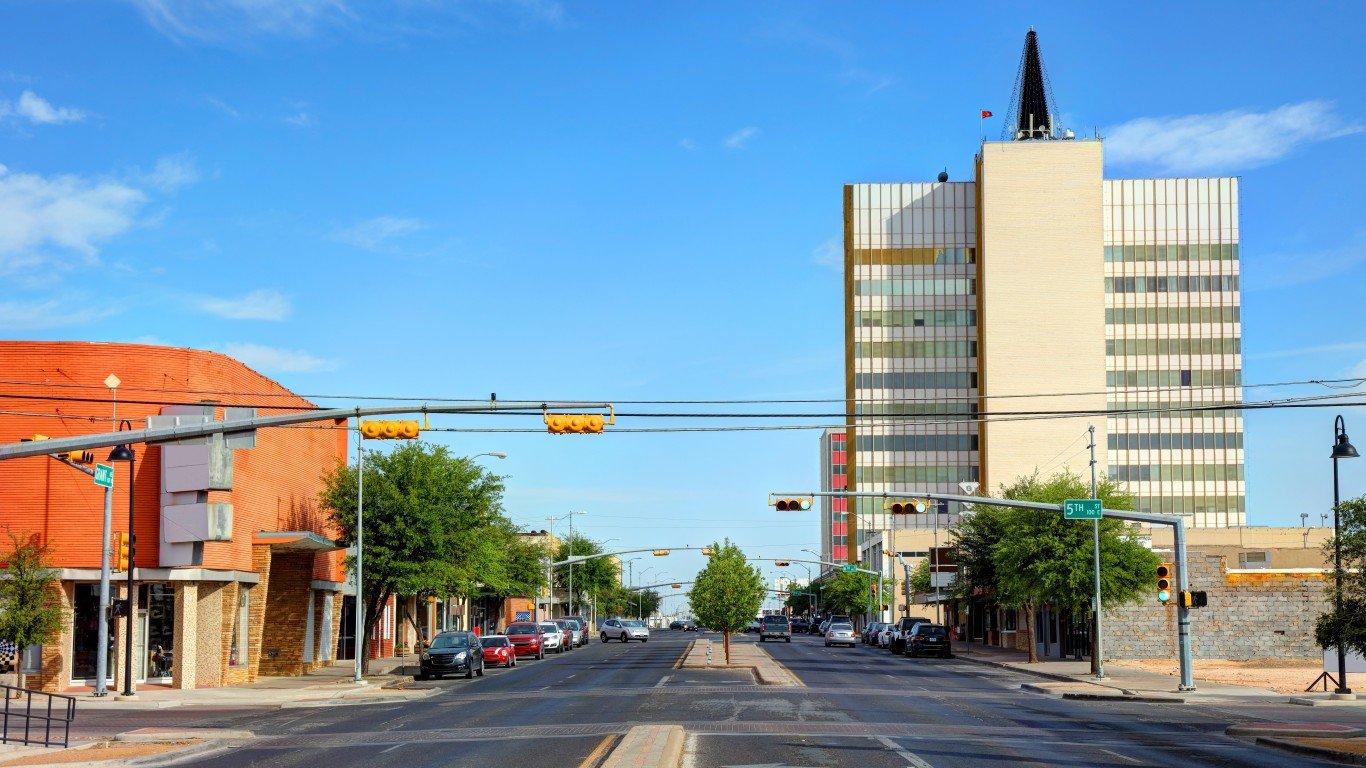
23. Ector County, Texas
> Workforce in high-risk industries: 33.1%
> COVID-19 cases per 10,000: 0.4 (as of March 31, 2020)
> Jan. 2020 unemployment rate: 3.4%
> Total population: 158,342
> Metropolitan area: Odessa
Like many parts of Texas, Ector County — part of the Odessa metropolitan area — depends heavily on the oil and gas extraction industry. Already, oil prices have plummeted this year, taking a deep dive to nearly $20 a barrel for West Texas Intermediate crude in March, the result of a price war between Saudi Arabia and Russia and a projected decline in global demand as a result of the pandemic. Some analysts project oil prices will continue to decline. Year-to-date WTI crude prices declined by over 50%. One of the largest employers in Ector County is oil field services company Halliburton. In total, nearly 13,000 Americans are employed in resource extraction across Ector County.

22. Boone County, Indiana
> Workforce in high-risk industries: 33.0%
> COVID-19 cases per 10,000: 3.4 (as of March 31, 2020)
> Jan. 2020 unemployment rate: 2.7%
> Total population: 64,321
> Metropolitan area: Indianapolis-Carmel-Anderson
More than 6,500 people in Boone County, Indiana, are employed in transportation and warehousing, or over one-fifth of the workforce. Transportation and warehousing is one of the sectors at higher risk of a sharp slowdown due to the coronavirus pandemic as manufacturing and consumer confidence declines will likely reduce demand for the sector overall.
Located in the Indianapolis metropolitan area, Boone County has greater than average population density, meaning the virus may be more likely to spread and affect a larger share of the local population. As of March 31, there are 22 confirmed cases of the virus in the county — or 3.4 for every 10,000 people. Nationwide, there are 5.8 cases per 10,000 people.
[in-text-ad-2]

21. Atlantic County, New Jersey
> Workforce in high-risk industries: 33.3%
> COVID-19 cases per 10,000: 1.2 (as of March 31, 2020)
> Jan. 2020 unemployment rate: 6.8%
> Total population: 268,539
> Metropolitan area: Atlantic City-Hammonton
As non-essential travel has effectively paused across the United States, few industries have been and will continue to be hit as hard tourism. In New Jersey’s Atlantic County — which is home to the beaches, casinos, boardwalk, and other attractions of Atlantic City — tourism is an economic pillar. Over 31% of workers in the county are employed in the leisure and hospitality industry, nearly three times the national concentration.
As of March 31, there were 31 known cases of coronavirus in Atlantic County, and on April 2, New Jersey Gov. Phil Murphy reported the first death attributable to coronavirus in the county.
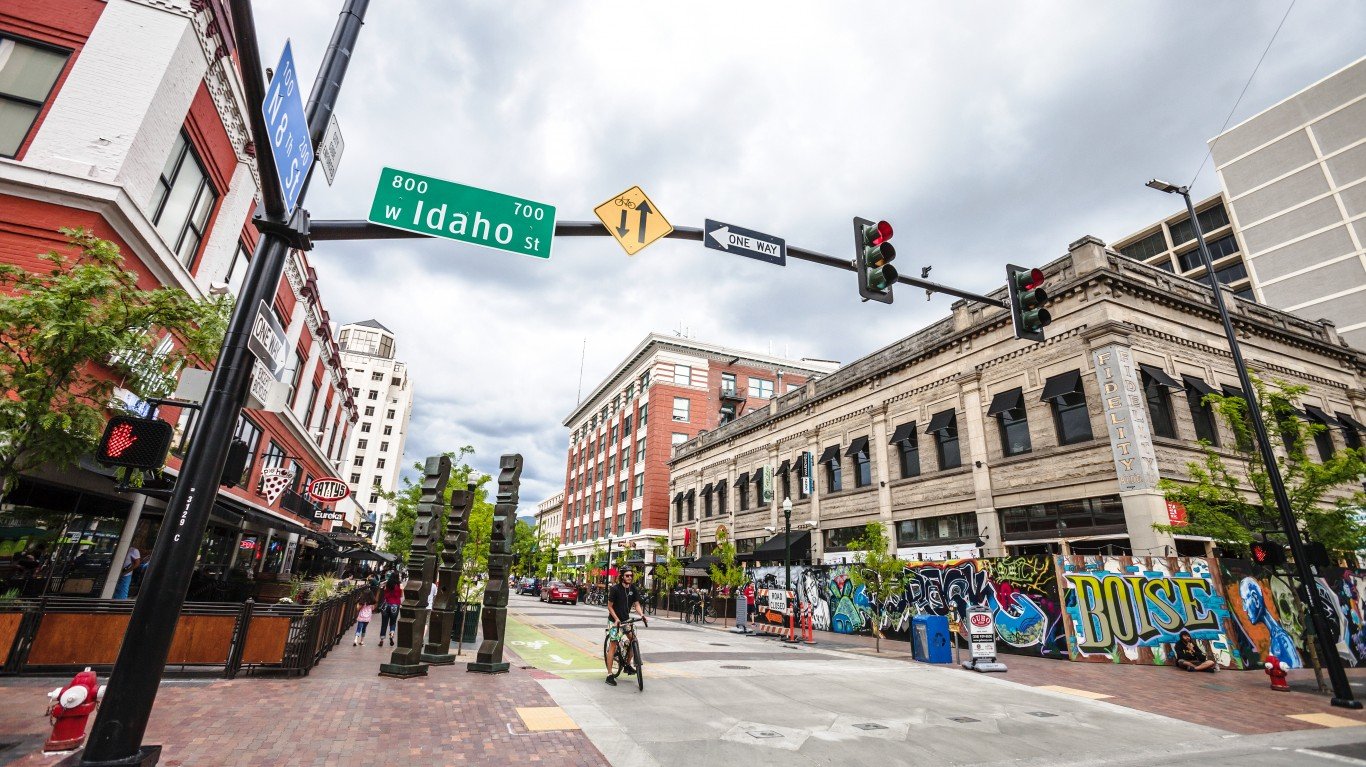
20. Boise County, Idaho
> Workforce in high-risk industries: 34.3%
> COVID-19 cases per 10,000: N/A (as of March 31, 2020)
> Jan. 2020 unemployment rate: 5.1%
> Total population: 7,163
> Metropolitan area: Boise City
Boise County, Idaho, is one of many U.S. counties that because of their heavy reliance on tourism will likely struggle economically in the near future, as more than 311 million Americans are currently being urged to stay at home. The area, located just outside the city of Boise, is popular for its scenic beauty. Nearly one-third of the 1,600 Americans employed in the area work in the leisure and hospitality industry.
[in-text-ad]
19. Lafourche Parish, Louisiana
> Workforce in high-risk industries: 33.5%
> COVID-19 cases per 10,000: 7.5 (as of March 31, 2020)
> Jan. 2020 unemployment rate: 5.3%
> Total population: 98,214
> Metropolitan area: Houma-Thibodaux
The Lafourche Parish in Louisiana is located along the Gulf Coast in the south of the state. The county has far higher than average employment concentration in resource extraction and transportation and warehousing — industries that are expected to be particularly hard hit by the economic slowdown brought on by the coronavirus epidemic.
Lafourche Parish is less than 50 miles from New Orleans, one of the cities hit hardest so far by the coronavirus. So far, there have been 74 confirmed cases of COVID-19 in Lafourche — or 7.5 per 10,000 people, higher than the national infection rate of 5.8 per 10,000.

18. Dinwiddie County, Virginia
> Workforce in high-risk industries: 34.4%
> COVID-19 cases per 10,000: N/A (as of March 31, 2020)
> Jan. 2020 unemployment rate: 3.5%
> Total population: 28,308
> Metropolitan area: Richmond
The transportation and warehousing industry typically follows broader economic trends in the United States. As economic activity slows in an attempt to contain the spread of the coronavirus, transportation and warehousing is projected to be among the hardest hit industries nationwide. In Dinwiddie County, Virginia — located in the Richmond metropolitan area — the industry employs over 30% of the local workforce.
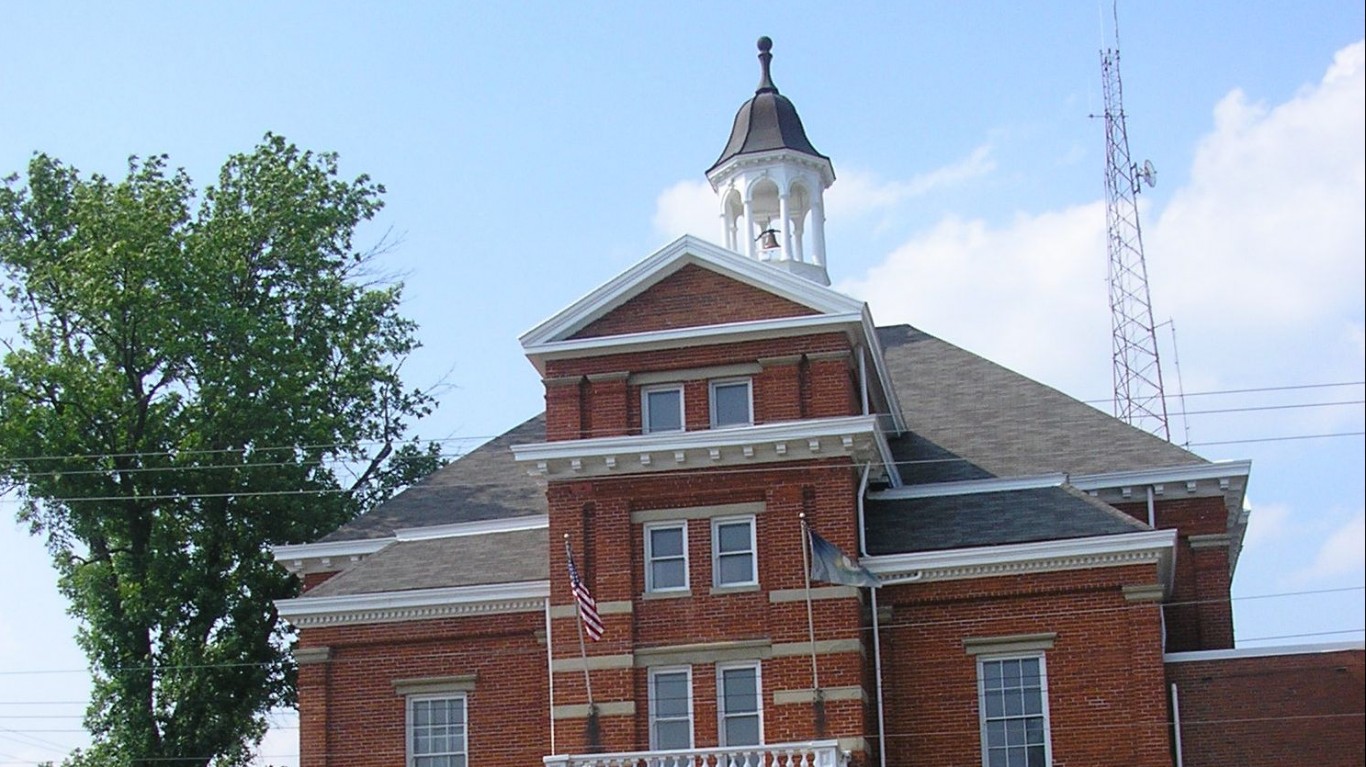
17. Boone County, Kentucky
> Workforce in high-risk industries: 34.5%
> COVID-19 cases per 10,000: 0.4 (as of March 31, 2020)
> Jan. 2020 unemployment rate: 3.8%
> Total population: 129,095
> Metropolitan area: Cincinnati
Boone County, Kentucky, is located in the northernmost section of the state and lies within the Cincinnati, Ohio, metropolitan area. Though the coronavirus infection rate remains far lower than average in the area, the local economy will likely be affected far worse than most. The county has far greater than average employment in both the services and transportation and warehousing industries — each of which is more exposed than most industries to economic slowdowns stemming from the effort to contain the COVID-19 outbreak.
[in-text-ad-2]

16. Orleans Parish, Louisiana
> Workforce in high-risk industries: 30.8%
> COVID-19 cases per 10,000: 47.1 (as of March 31, 2020)
> Jan. 2020 unemployment rate: 5.5%
> Total population: 389,648
> Metropolitan area: New Orleans-Metairie
Orleans Parish is the third-most populous parish in the state. In the parish, which is at the heart of New Orleans, over 30% of the workforce is employed in industries that are the most exposed to revenue losses and job cuts from the instituted lockdowns that aim to stop the spread of the coronavirus. As of the end of March, the parish had the most cases in the state and an infection rate more than double that of almost every other parish in the state.
New Orleans relies heavily on its tourism and leisure and hospitality industries — including bars and restaurants such as those found in the famous French Quarter, all of which have been effectively shut down.

15. Clark County, Nevada
> Workforce in high-risk industries: 35.4%
> COVID-19 cases per 10,000: 4.1 (as of March 31, 2020)
> Jan. 2020 unemployment rate: 3.9%
> Total population: 2.1 million
> Metropolitan area: Las Vegas-Henderson-Paradise
Clark County covers the southernmost part of Nevada and includes the city of Las Vegas. As is the case in many of the counties and county equivalents on this list, Clark County’s economy is heavily dependent on tourism. Las Vegas alone draws more than 40 million visitors annually, and nearly 300,000 people in Clark County work in the leisure and hospitality industry. As of April 5, there have been more than 1,600 cases of coronavirus and 41 deaths in Clark County.
[in-text-ad]

14. Hendricks County, Indiana
> Workforce in high-risk industries: 35.8%
> COVID-19 cases per 10,000: 4.3 (as of March 31, 2020)
> Jan. 2020 unemployment rate: 2.8%
> Total population: 160,940
> Metropolitan area: Indianapolis-Carmel-Anderson
The economy in Hendricks County, Indiana, is heavily dependent on transportation and warehousing and employment services — two industries likely to be hit especially hard by the efforts to contain the coronavirus outbreak. The county’s unemployment rate in January was among the lowest in the country at just 2.8%. As industry and non-essential travel and business grind to a halt and consumer confidence slides down in the coming months, unemployment will likely spike. More than 25,000 workers in the county are employed in industries highly exposed to the likely economic effects of COVID-19.
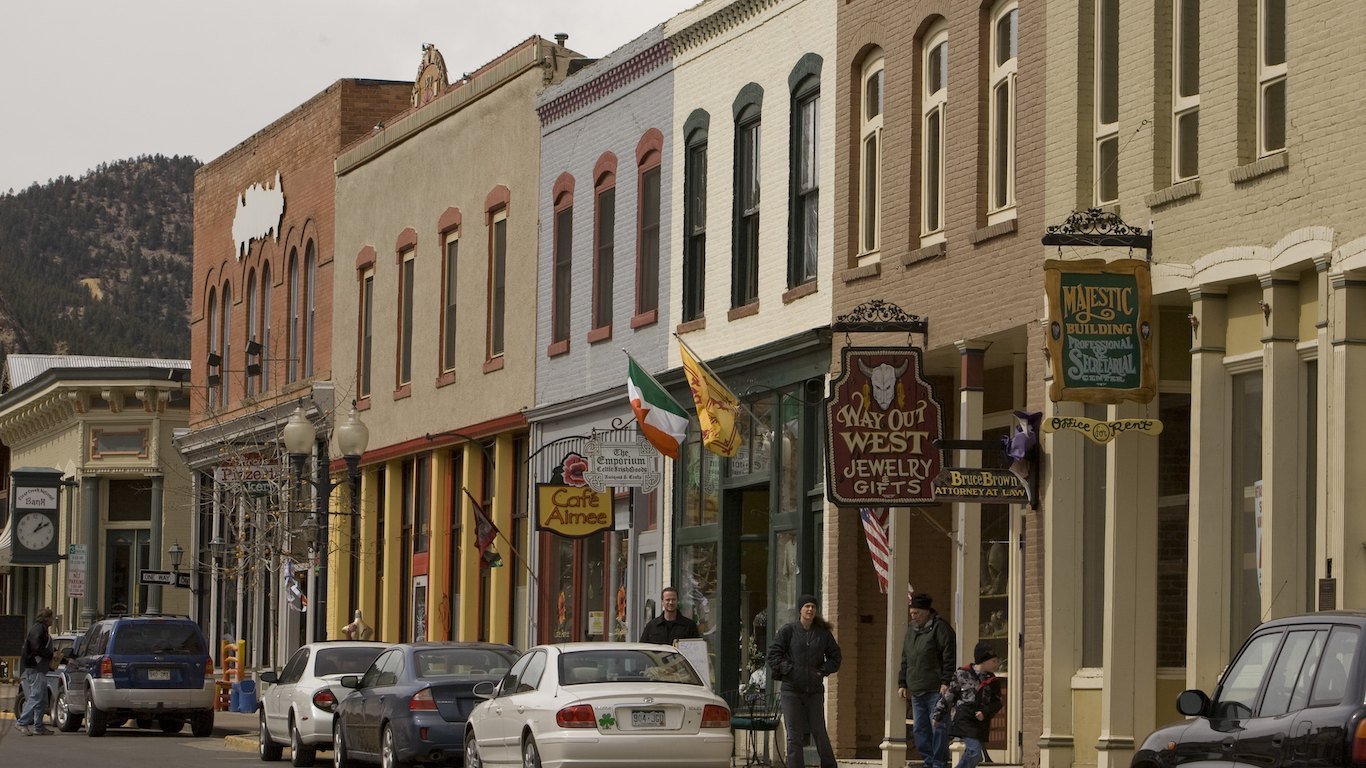
13. Clear Creek County, Colorado
> Workforce in high-risk industries: 37.4%
> COVID-19 cases per 10,000: 4.3 (as of March 31, 2020)
> Jan. 2020 unemployment rate: 2.3%
> Total population: 9,379
> Metropolitan area: Denver-Aurora-Lakewood
In Clear Creek County, Colorado, tourism is an economic pillar. The county is located in the Denver metropolitan area and is notable for its scenic beauty. More than 35% of the 3,100 people working in the county work in the leisure and hospitality industry. As non-essential travel has effectively ground to a halt in the United States, many of those jobs in the county are at stake.
In addition to the economic threat, a relatively large share of county residents are at elevated risk of serious illness and death from coronavirus. The death rates from COVID-19 have been significantly higher among older Americans, and in Clear Creek County, 18.9% of the population are 65 and older, compared to 15.2% of Americans nationwide.

12. Williamsburg, Virginia
> Workforce in high-risk industries: 37.4%
> COVID-19 cases per 10,000: 5.4 (as of March 31, 2020)
> Jan. 2020 unemployment rate: 4.2%
> Total population: 14,788
> Metropolitan area: Virginia Beach-Norfolk-Newport News
Some 37% of Williamsburg’s workforce as of 2018 were employed in industries that are especially at risk of serious revenue losses and job cuts resulting from the efforts to contain the coronavirus pandemic, including tourism and leisure and hospitality.
Williamsburg, which is part of the Virginia Beach-Norfolk-Newport News metropolitan area, is a historic city — it was one of the first major settlements in the United States — and is a popular tourist destination. The Colonial Williamsburg historic sites are all closed as of the time of this writing because of the outbreak.
[in-text-ad-2]
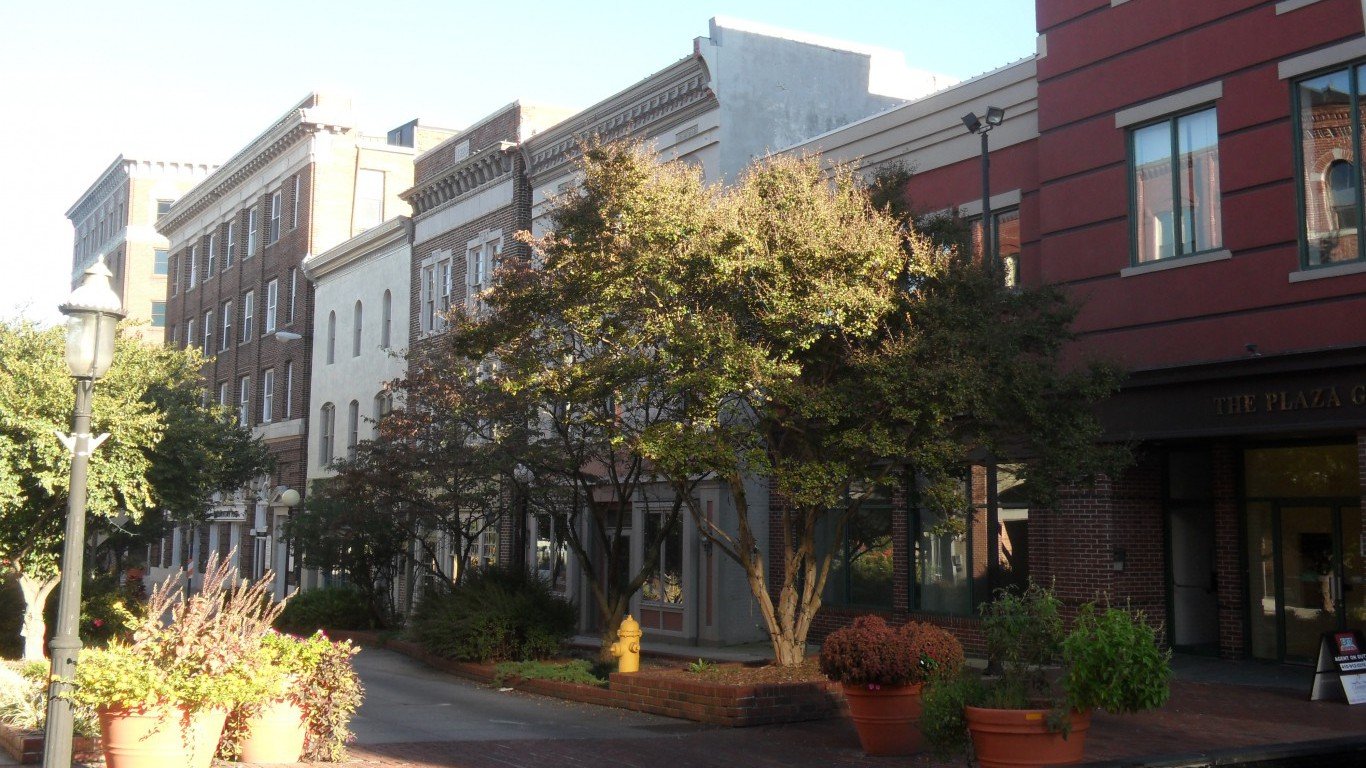
11. Worcester County, Maryland
> Workforce in high-risk industries: 38.2%
> COVID-19 cases per 10,000: 0.6 (as of March 31, 2020)
> Jan. 2020 unemployment rate: 10.9%
> Total population: 51,564
> Metropolitan area: Salisbury
Worcester is the easternmost county in Maryland — and with miles of coastline along the Atlantic Ocean, the county is a popular tourist destination. As non-essential travel has been effectively eliminated in an attempt to contain the coronavirus pandemic, many of the 9,000 jobs in the leisure and hospitality industry in the country are at risk.
As of January, the county’s unemployment rate of 10.9% was already among the highest in the country. The economic toll caused by the coronavirus will almost certainly push unemployment even higher.

10. DeSoto County, Mississippi
> Workforce in high-risk industries: 38.5%
> COVID-19 cases per 10,000: 4.8 (as of March 31, 2020)
> Jan. 2020 unemployment rate: 4.3%
> Total population: 176,132
> Metropolitan area: Memphis
DeSoto County is situated in the northwestern corner of Mississippi and lies within the Memphis, Tennessee, metropolitan area. The county has higher than average employment in the leisure and hospitality, employment services, and transportation and warehousing industries — each of which is at high risk of significant slowdown in the face of the coronavirus pandemic.
So far, DeSoto has among the most confirmed cases of the virus in Mississippi, and by far the most cases of the five Mississippi counties within the Memphis metropolitan area.
[in-text-ad]
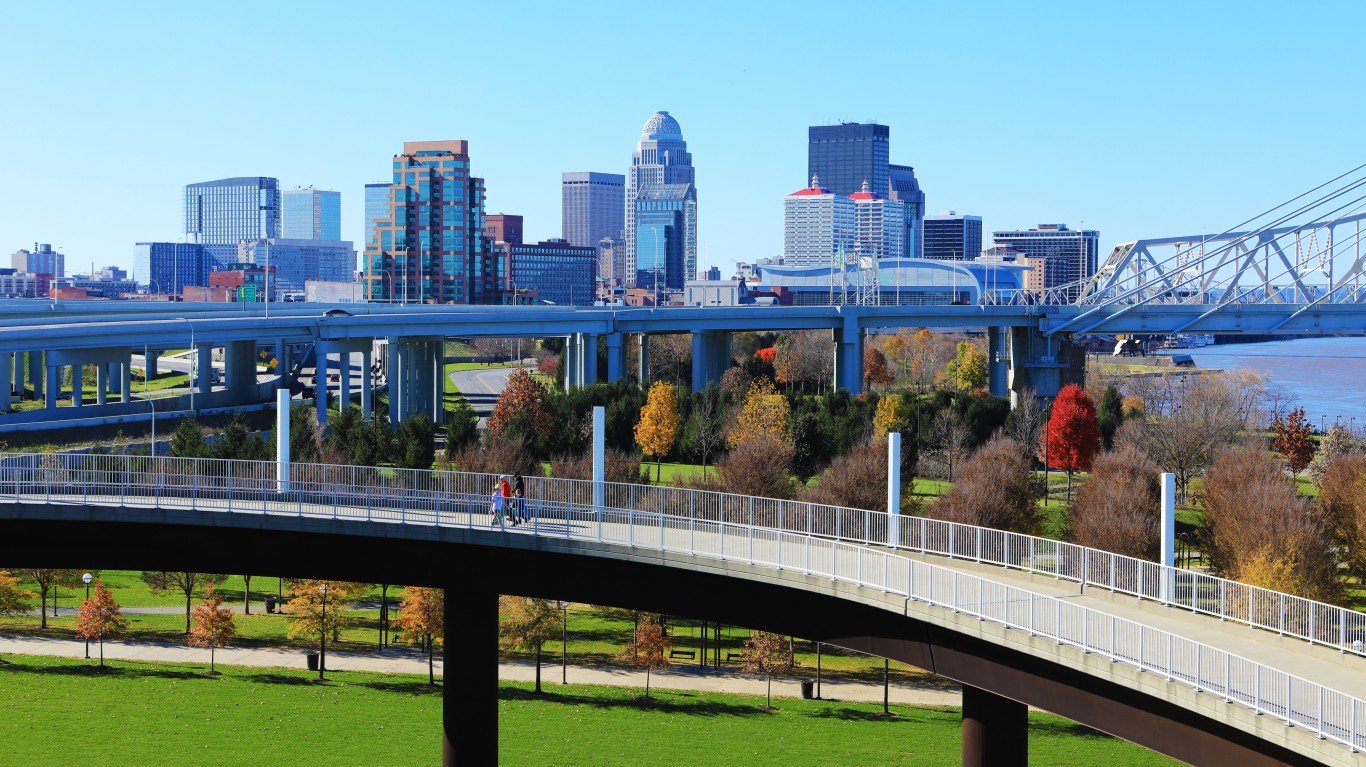
9. Bullitt County, Kentucky
> Workforce in high-risk industries: 40.5%
> COVID-19 cases per 10,000: 0.8 (as of March 31, 2020)
> Jan. 2020 unemployment rate: 4.3%
> Total population: 79,466
> Metropolitan area: Louisville/Jefferson County
Employment in Bullitt County is disproportionately concentrated in industries that are highly susceptible to a slowdown as a result of the coronavirus pandemic and the efforts to contain the spread — particularly transportation and warehousing. The industry, which is at higher risk of a drop in demand as manufacturing and consumer confidence decline, accounts for 29% of all employment in the county. Nationwide, only 3.6% of the workforce is employed in transportation and warehousing.

8. Maui County, Hawaii
> Workforce in high-risk industries: 40.8%
> COVID-19 cases per 10,000: 1.5 (as of March 31, 2020)
> Jan. 2020 unemployment rate: 2.8%
> Total population: 165,281
> Metropolitan area: Kahului-Wailuku-Lahaina
In Maui County, Hawaii, jobs in the leisure and hospitality industry are about three times more concentrated than they are nationwide. The county covers the island of Maui, which is the second most visited island in the state, drawing in about 2.4 million visitors annually. As non-essential travel effectively stops nationwide, many of the more than 1,300 jobs in places like resorts and hotels across the county are in jeopardy.
Though the county has not been as hard hit in terms of confirmed cases per capita as much of the rest of the country has, local lawmakers are concerned about the virus’s spread, particularly in rural areas.

7. Midland County, Texas
> Workforce in high-risk industries: 43.0%
> COVID-19 cases per 10,000: 0.8 (as of March 31, 2020)
> Jan. 2020 unemployment rate: 2.4%
> Total population: 164,194
> Metropolitan area: Midland
Midland County — one of the two counties in the Midland, Texas, metro area — had a relatively low coronavirus infection rate of 0.8 cases per 100,000 people as of the end of March, but the county’s employment structure is one of the most at-risk in the country. Well over 40% of the county’s workforce is employed in industries that are being hit especially hard across the country.
Midland is a major oil producer in Texas thanks to the development of fracking in the Permian basin. Over 28% of the county’s workforce is employed in the mining, quarrying, and oil and gas extraction sector, compared to 0.5% of the national workforce. Oil extraction has been and will likely continue to be one of the worst-affected industries in the country, in large part because the major dropoff in travel has caused oil and gas prices to plummet in 2020.
[in-text-ad-2]

6. Ohio County, Indiana
> Workforce in high-risk industries: 44.0%
> COVID-19 cases per 10,000: 1.7 (as of March 31, 2020)
> Jan. 2020 unemployment rate: 4.1%
> Total population: 5,887
> Metropolitan area: Cincinnati
Travel is the lifeblood of the leisure and hospitality industry. As over 300 million Americans are being urged or ordered by elected officials to remain home in an effort to contain the pandemic, the leisure and hospitality industry is expected to be among the hardest hit. In Ohio County, Indiana, which falls within the Cincinnati, Ohio, metro area, a staggering 44% of the labor force works in the leisure and hospitality industry. However, the number of confirmed infections in Ohio County remains well below the number of cases in the surrounding counties.

5. Irion County, Texas
> Workforce in high-risk industries: 47.5%
> COVID-19 cases per 10,000:. (as of March 31, 2020)
> Jan. 2020 unemployment rate: 2.5%
> Total population: 1,524
> Metropolitan area: San Angelo
Like Midland, the economy of Irion County, which is part of the San Angelo metropolitan area in west Texas, heavily relies on oil extraction. The extraction sector, which includes oil extraction, employs over 40% of the county’s workforce — the fourth highest share of any county in the United States.
[in-text-ad]

4. Clayton County, Georgia
> Workforce in high-risk industries: 50.6%
> COVID-19 cases per 10,000: 4.0 (as of March 31, 2020)
> Jan. 2020 unemployment rate: 4.2%
> Total population: 278,666
> Metropolitan area: Atlanta-Sandy Springs-Alpharetta
Clayton County, Georgia, is one of only a handful of counties and county equivalents nationwide where over half of all workers are employed in industries at the greatest risk of a slowdown attributable to the efforts to contain the coronavirus. More than one-third of all area workers are employed in transportation and warehousing, and about one in 10 work in leisure and hospitality.
While the county reported fewer cases of COVID-19 on a per capita basis at the end of March, the number of infections has climbed rapidly since and so far the county reported nine related deaths. Rapid spread is more likely in densely populated areas, and in Clayton County — located in the Atlanta metro area — there are nearly 2,000 people per square mile. Nationwide, there are only about 90 people per square mile.
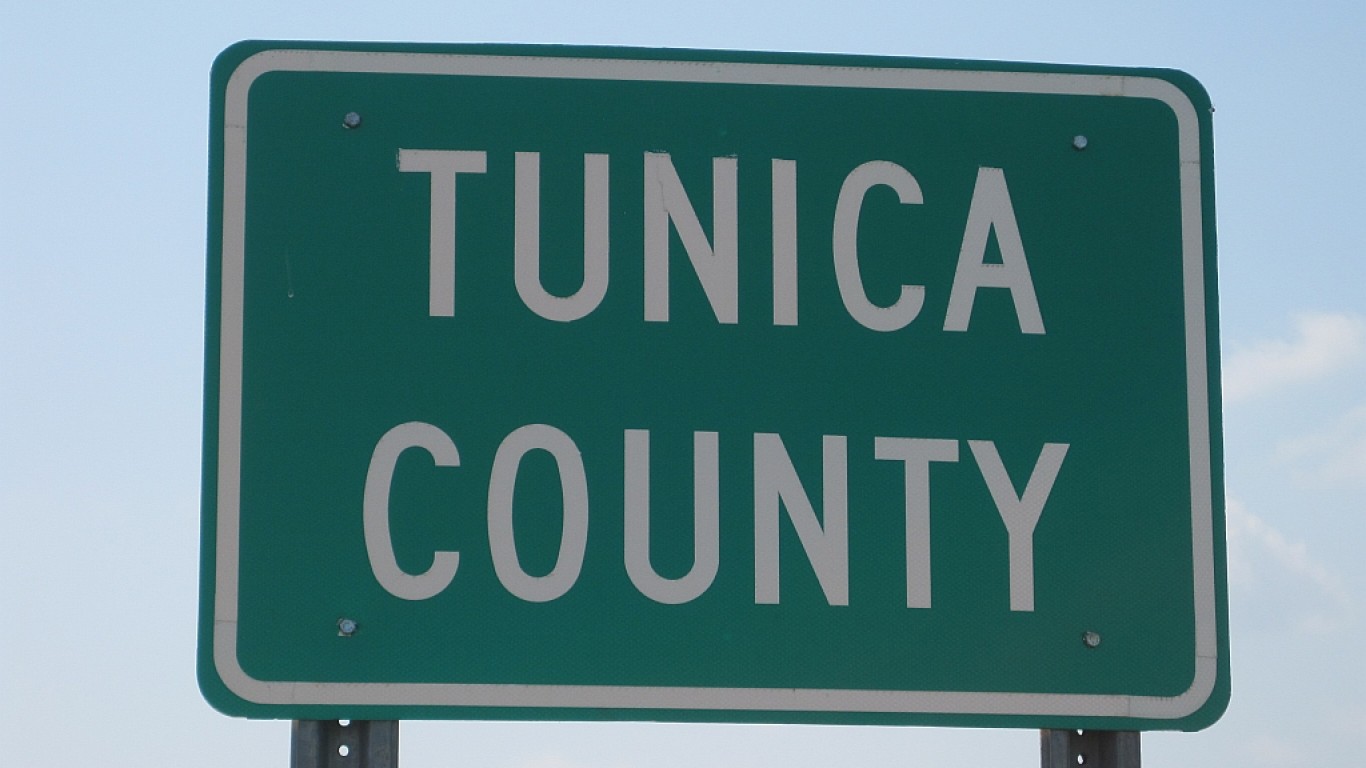
3. Tunica County, Mississippi
> Workforce in high-risk industries: 61.6%
> COVID-19 cases per 10,000: 11.8 (as of March 31, 2020)
> Jan. 2020 unemployment rate: 6.7%
> Total population: 10,170
> Metropolitan area: Memphis
Tunica County, Mississippi, is one of only a handful of counties and county equivalents in the United States where over 60% of workers are employed in industries that are highly exposed to the economic fallout of the coronavirus pandemic. In the county, which is located along the Mississippi River just south of Memphis, the majority of workers are employed in leisure and hospitality — an industry that has been all but shut down in much of the country as over 300 million Americans are being urged to stay home.
Unemployment in the county — which was bad to begin with as 6.7% of the workforce was out of a job in January — will likely only worsen before it gets better.

2. Twiggs County, Georgia
> Workforce in high-risk industries: 63.8%
> COVID-19 cases per 10,000: 2.4 (as of March 31, 2020)
> Jan. 2020 unemployment rate: 6.0%
> Total population: 8,284
> Metropolitan area: Macon-Bibb County
Well over 60% of workers in Twiggs County, Georgia, are employed in the transportation and warehousing industry — by far the highest concentration of any U.S. county and almost double the county with the next highest concentration.
The disruptions to supply chains in the U.S. and globally, as well as a reduced demand for goods as a result of the economic slowdown, is expected to have serious consequences for the industry. The greater region is home to the junction of two major highways, I-16 and I-75.
[in-text-ad-2]
1. Gilpin County, Colorado
> Workforce in high-risk industries: 82.2%
> COVID-19 cases per 10,000: N/A (as of March 31, 2020)
> Jan. 2020 unemployment rate: 2.3%
> Total population: 5,924
> Metropolitan area: Denver-Aurora-Lakewood
Located just outside of Denver, Gilpin County, Colorado, is known for its scenic beauty and casinos. Its economy will likely be decimated by efforts to contain the coronavirus as more than 80% of all workers in the area are employed in leisure and hospitality. The entire state has been under a stay-at-home order, issued by Gov. Jared Polis, since March 26, and tourism nationwide has effectively stopped. Though cases of the virus have so far been identified in 50 counties across Colorado, there has yet to be a known case in Gilpin County.
Methodology
To determine the local economies most at risk from the coronavirus pandemic, 24/7 Wall St. created a weighted index of three measures. The first measure, which comprises 80% of the index, is the share of total employment in industries deemed to be at high-risk of slowdown due to the coronavirus outbreak. The second measure, which comprises 10% of the index, is the coronavirus infection rate per capita as of March 31 2020. The final 10% of the index is the number of people per square mile, as higher population density appears to make the spread of the virus more likely. We only considered counties and county equivalents that fall within a metropolitan area because metro areas are typically hubs of economic activity.
The identification of high-risk industries comes from the March 2020 paper “COVID-19: A Fiscal Stimulus Plan” published by Moody’s Analytics. Employment data by industry came from the Bureau of Labor Statistics’ Quarterly Census of Employment and Wages and are annual estimates for 2018.
Data on COVID-19 cases and deaths by county and state came from the New York Times and are current as of March 31, 2020. COVID-19 cases and death toll were adjusted for population using five-year estimates from the U.S. Census Bureau’s 2018 American Community Survey. The NYT provides one aggregated measure for the five counties that comprise New York City, so the five counties that constitute New York City — New York, Kings, Queens, Bronx, and Richmond — were assigned the same COVID-19 per capita rates that are representative of New York City as a whole.
Population density was calculated using 2010 land area estimates from the Census Bureau and five-year population estimates from the 2018 ACS. Data on the percentage of the population that is 65 years and older are also five-year estimates from the 2018 ACS.
Sponsored: Want to Retire Early? Here’s a Great First Step
Want retirement to come a few years earlier than you’d planned? Or are you ready to retire now, but want an extra set of eyes on your finances?
Now you can speak with up to 3 financial experts in your area for FREE. By simply clicking here you can begin to match with financial professionals who can help you build your plan to retire early. And the best part? The first conversation with them is free.
Click here to match with up to 3 financial pros who would be excited to help you make financial decisions.
Thank you for reading! Have some feedback for us?
Contact the 24/7 Wall St. editorial team.

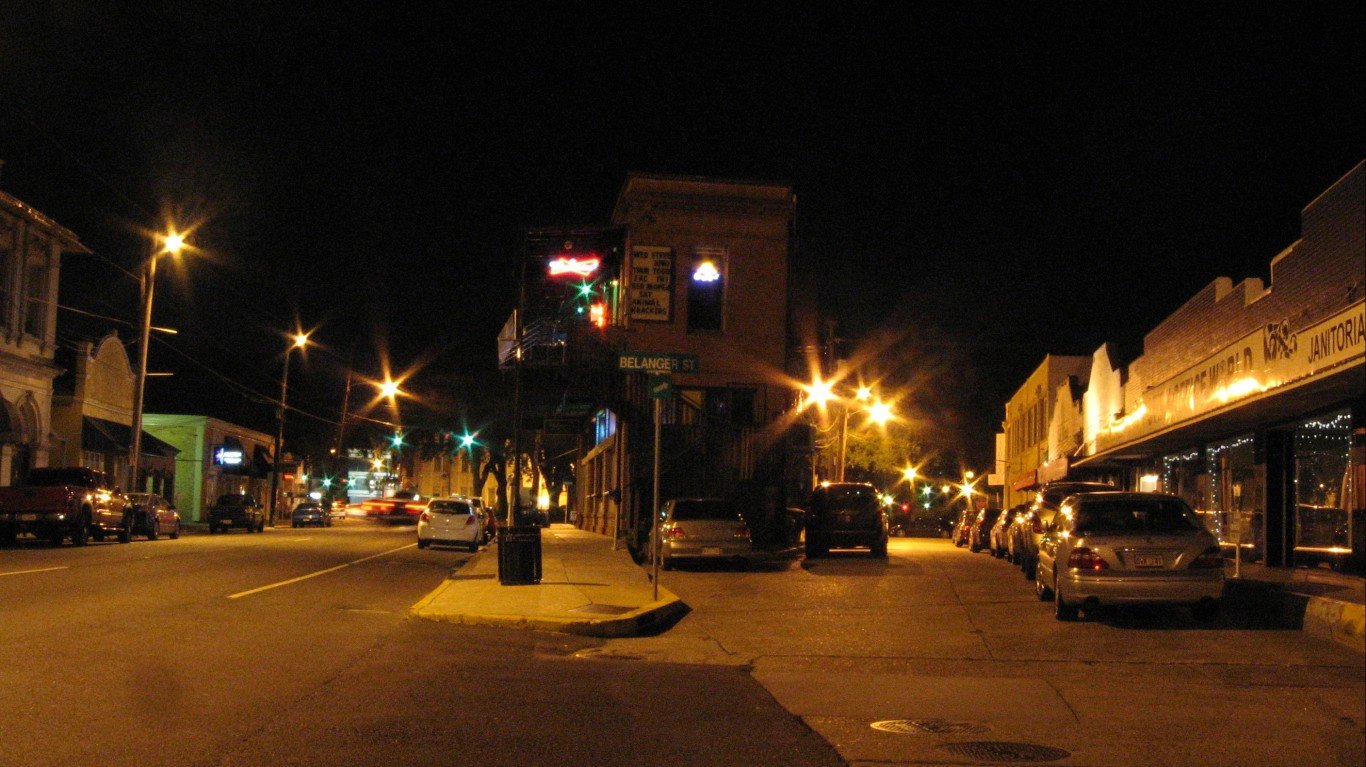
 24/7 Wall St.
24/7 Wall St.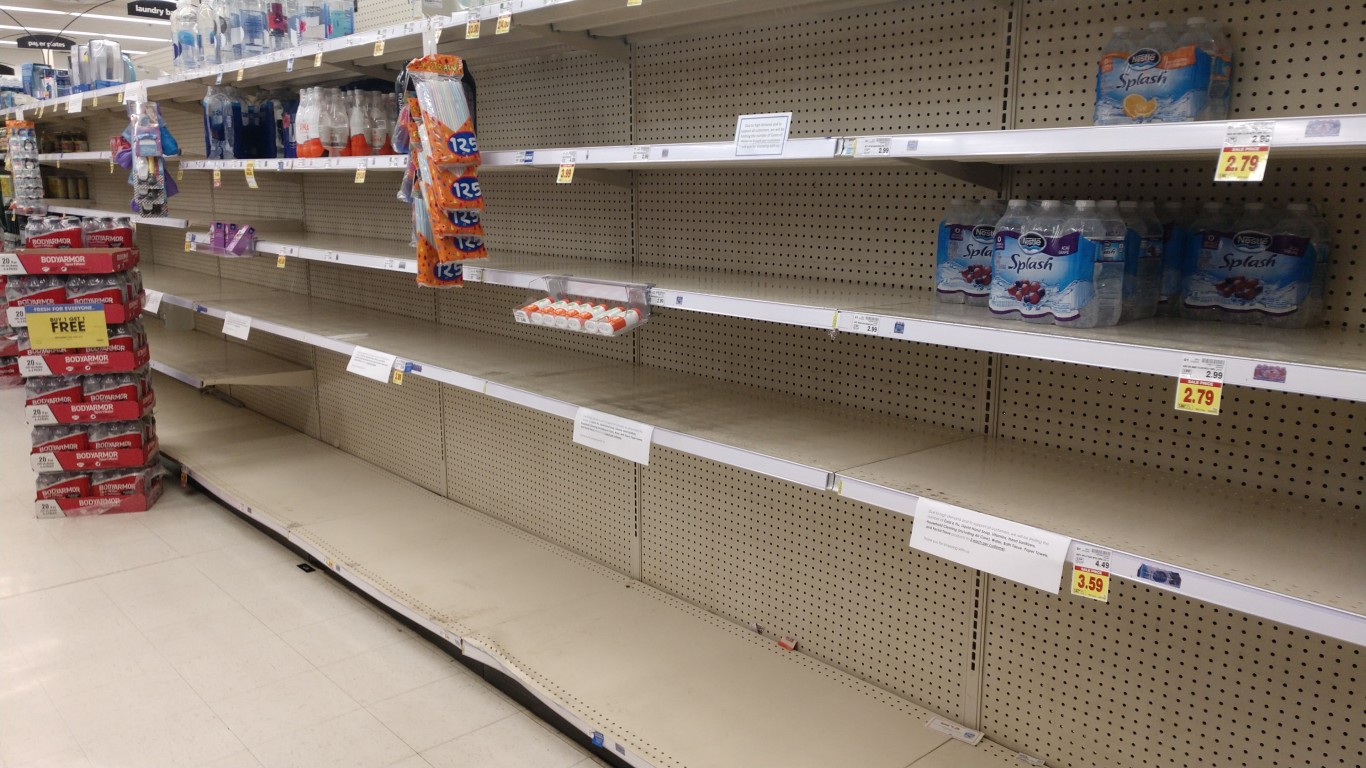 24/7 Wall St.
24/7 Wall St.



